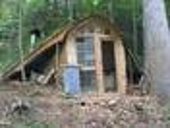R Scott wrote:I am not sure if lime or earth plaster is better at regulating humidity but lime is a great anti mold finish.
I wouldn't know myself, but Athena Steen of Canelo project says clay is a much better humidity regulator than lime. At a workshop she mentioned that many people use lime in the bathroom but (on walls not directly hit by water) clay is much better at regulating humidity.
At Canelo they use lime (or possibly limecrete) for shower walls but clay for, e.g., above the sink or other areas iin the bathroom.
For our house and needs (we said we didn't want to resurface regularly, and the south-facing wall has a 2' overhang) she suggested 1:3 cement:lime stucco mix for that upper exposed south-facing wall. Below the porch roof on that same wall we plan to use clay even though it will be a greenhouse and therefore humid -- we won't have any planters against the walll.








